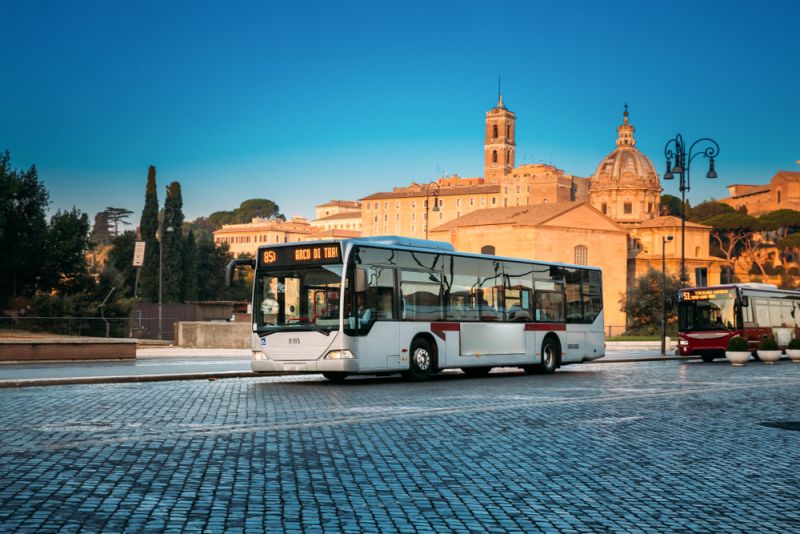Italy: How to use public transport in Rome

Rome: Depending on how long you have to wait – it can be the quickest, and certainly the cheapest, way to get across Rome. A €1.50 ticket allows you to use buses, metro (underground/subway), trams (streetcars), and light rail lines, which are operated by the city transport company ATAC. This €1.50 ticket can be used multiple times for the duration of its 100 minutes, although it is only valid for one journey on the metro.
The best place to buy tickets is at a tobacconist (tabacchi), recognisable by a black and white sign with a ‘T’ displayed outside. Tickets (biglietti) can also be bought from machines in metro stations but it is best to use exact change (coins if possible) and not large notes.
The machines can be used in English. Note the word for change in Italian is “resto”, while “fuori servizio” means the machine is out of order. It is also possible to buy tickets at most parking metres; and at certain edicole (newsstands). In a limited number of cases tickets can be bought on board Rome’s buses but don’t bank on it. And don’t even think of asking the drivers – they don’t sell tickets.
Tickets must be validated once boarding the bus (just once even if using multiple times during the 100 minutes) by inserting the ticket into the yellow machines located either towards the front or back of the bus. Once validated the ticket will be printed with an expiry time (scadenza).
This is the same for the city’s trams. Not stamping your ticket can result in a hefty fine. Note: Buses should be boarded at the front or back entrance while the middle doors are supposed to be exit only. Athough this system is frequently ignored by Romans, as a tourist prepare to be ticked off for trying to enter a packed bus via the middle doors.
The €1.50 standard ticket is valid for one journey on the subway and must be validated at the turnstiles before reaching the platform. It is also possible to pay by credit card, via tap & go, see ATAC website.
Rome has three Metro lines – A (red), B (blue) and C (green) – with most tourists using the Metro A line (which is connected to St Peter’s). Both the A and B line reach Rome’s central Termini train station. The B line splits in two directions at Bologna, going to Jonio or Rebibbia. Metro C is still under construction but is functional from the suburbs up to S. Giovanni, near the city centre, where it meets the A line. See map.
Rome’s metro begins at 05.30 every day, seven days a week. The last train leaves at 23.30 on weeknights, running until 01.30 on Friday and Saturday nights.
The city is served by a network of night buses, or linee notturne, that operate in the wee hours between midnight and dawn. See ATAC website.
ATAC operates a number of train lines, meaning that you can use your ticket within the city limits, with access to major train stations such as Termini, Trastevere, Tiburtina and Ostiense. It is even possible to reach the seaside town of Ostia using the standard €1.50 ticket but you cannot get to Fiumicino airport. See map of Rome’s train and metro lines.
100 minutes. This is the standard €1.50 ticket which can be used multiple times on buses, trams and light rail within 100 minutes but only once on the metro.
24 hours. Once validated this €7 ticket offers 24 hours of limitless trips on Rome public transport.
48 hours. Once validated this €12.50 ticket offers 48 hours of limitless trips on Rome public transport.
72 hours. Once validated this €18 ticket offers 72 hours of limitless trips on Rome public transport.
Weekly ticket. From the moment of validation this €24 ticket is valid for seven days, until midnight on the seventh day.
Monthly ticket. For tourists staying for a couple of weeks or more this is definitely the best option. For just €35 you have free public transport for the month. But be warned, this ticket (tessera mensile) is valid for calendar months, meaning that if you arrive mid-way through the month and are staying in Rome into the next calendar month, it may not be the best option for you. See ATAC website for full details.
Public transport in Rome, particularly during rush hour, can be an unenjoyable experience due to overcrowding, and the system can be hampered by lengthy delays and frequent strikes. Using mobility apps such as Moovit will tell you which buses are coming next and how long you have to wait.





